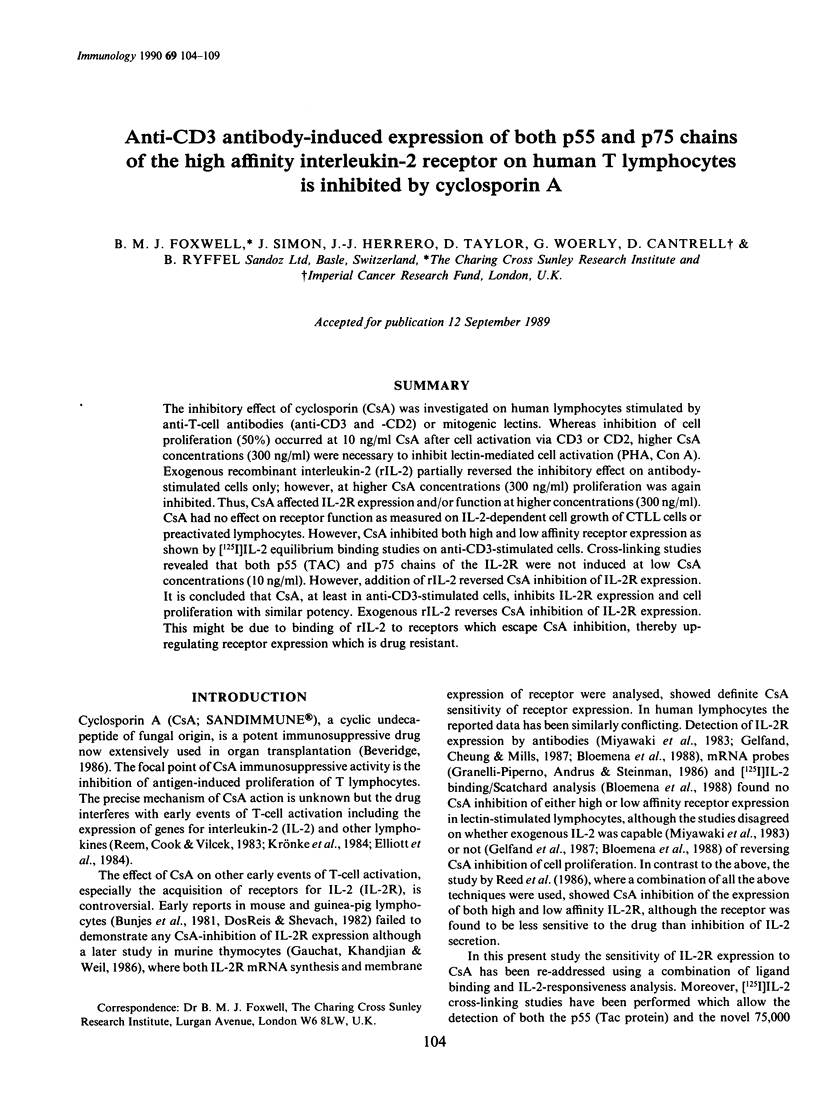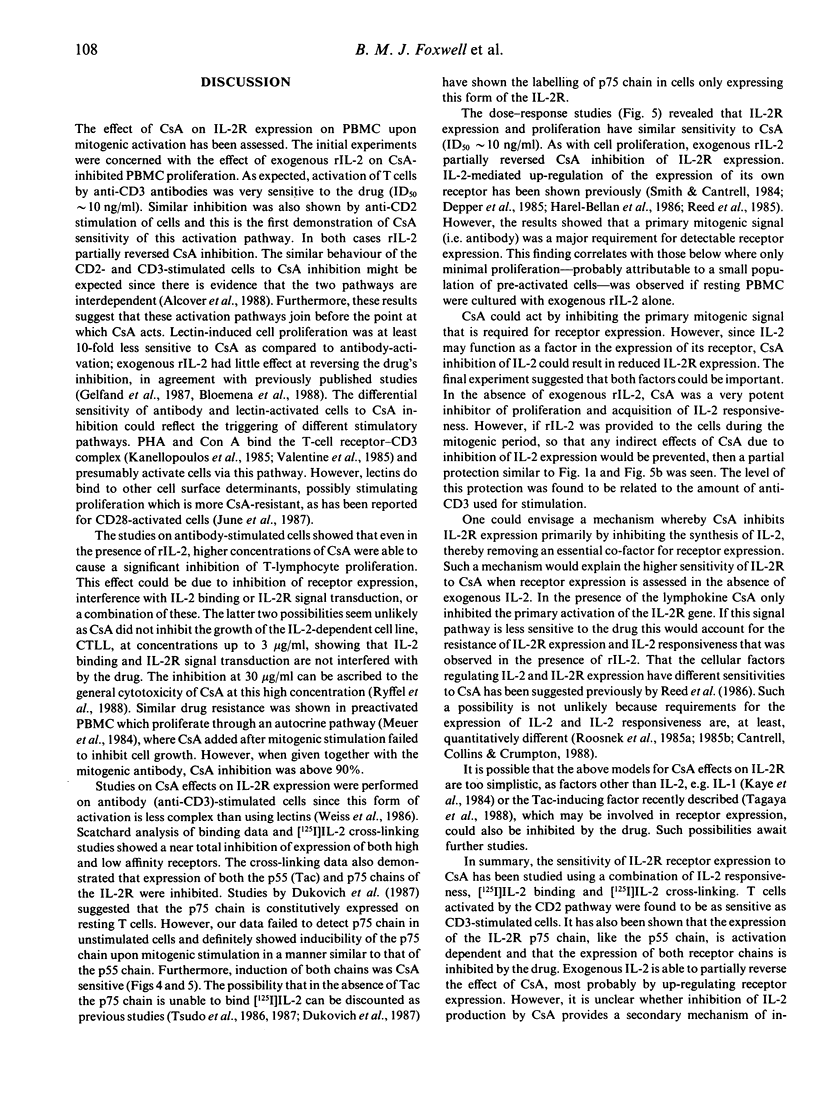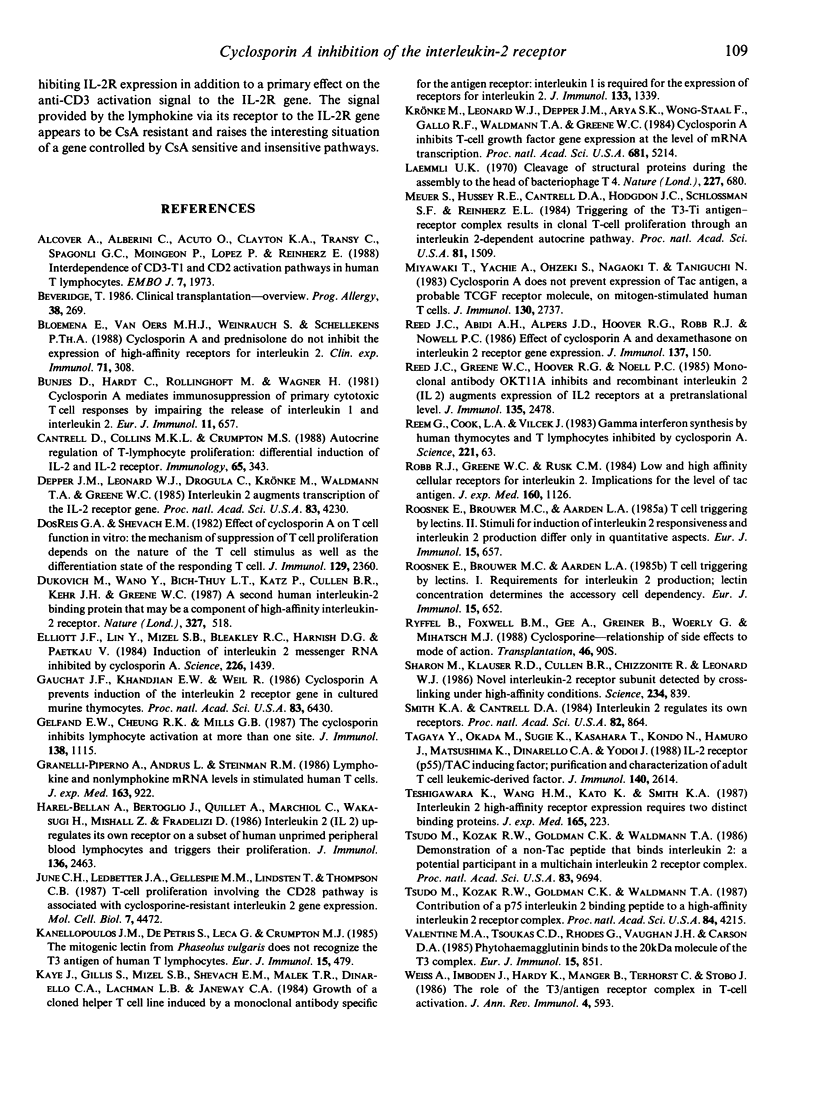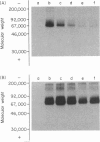Abstract
The inhibitory effect of cyclosporin (CsA) was investigated on human lymphocytes stimulated by anti-T-cell antibodies (anti-CD3 and -CD2) or mitogenic lectins. Whereas inhibition of cell proliferation (50%) occurred at 10 ng/ml CsA after cell activation via CD3 or CD2, higher CsA concentrations (300 ng/ml) were necessary to inhibit lectin-mediated cell activation (PHA, Con A). Exogenous recombinant interleukin-2 (rIL-2) partially reversed the inhibitory effect on antibody-stimulated cells only; however, at higher CsA concentrations (300 ng/ml) proliferation was again inhibited. Thus, CsA affected IL-2R expression and/or function at higher concentrations (300 ng/ml). CsA had no effect on receptor function as measured on IL-2-dependent cell growth of CTLL cells or preactivated lymphocytes. However, CsA inhibited both high and low affinity receptor expression as shown by [125I]IL-2 equilibrium binding studies on anti-CD3-stimulated cells. Cross-linking studies revealed that both p55 (TAC) and p75 chains of the IL-2R were not induced at low CsA concentrations (10 ng/ml). However, addition of rIL-2 reversed CsA inhibition of IL-2R expression. It is concluded that CsA, at least in anti-CD3-stimulated cells, inhibits IL-2R expression and cell proliferation with similar potency. Exogenous rIL-2 reverses CsA inhibition of IL-2R expression. This might be due to binding of rIL-2 to receptors which escape CsA inhibition, thereby up-regulating receptor expression which is drug resistant.
Full text
PDF





Images in this article
Selected References
These references are in PubMed. This may not be the complete list of references from this article.
- Alcover A., Alberini C., Acuto O., Clayton L. K., Transy C., Spagnoli G. C., Moingeon P., Lopez P., Reinherz E. L. Interdependence of CD3-Ti and CD2 activation pathways in human T lymphocytes. EMBO J. 1988 Jul;7(7):1973–1977. doi: 10.1002/j.1460-2075.1988.tb03035.x. [DOI] [PMC free article] [PubMed] [Google Scholar]
- Beveridge T. Clinical transplantation--overview. Prog Allergy. 1986;38:269–292. [PubMed] [Google Scholar]
- Bloemena E., Van Oers M. H., Weinreich S., Schellekens P. T. Cyclosporin A and prednisolone do not inhibit the expression of high-affinity receptors for interleukin 2. Clin Exp Immunol. 1988 Feb;71(2):308–313. [PMC free article] [PubMed] [Google Scholar]
- Bunjes D., Hardt C., Röllinghoff M., Wagner H. Cyclosporin A mediates immunosuppression of primary cytotoxic T cell responses by impairing the release of interleukin 1 and interleukin 2. Eur J Immunol. 1981 Aug;11(8):657–661. doi: 10.1002/eji.1830110812. [DOI] [PubMed] [Google Scholar]
- Cantrell D. A., Collins M. K., Crumpton M. J. Autocrine regulation of T-lymphocyte proliferation: differential induction of IL-2 and IL-2 receptor. Immunology. 1988 Nov;65(3):343–349. [PMC free article] [PubMed] [Google Scholar]
- Depper J. M., Leonard W. J., Drogula C., Krönke M., Waldmann T. A., Greene W. C. Interleukin 2 (IL-2) augments transcription of the IL-2 receptor gene. Proc Natl Acad Sci U S A. 1985 Jun;82(12):4230–4234. doi: 10.1073/pnas.82.12.4230. [DOI] [PMC free article] [PubMed] [Google Scholar]
- Dos Reis G. A., Shevach E. M. Effect of cyclosporin A on T cell function in vitro: the mechanism of suppression of T cell proliferation depends on the nature of the T cell stimulus as well as the differentiation state of the responding T cell. J Immunol. 1982 Dec;129(6):2360–2367. [PubMed] [Google Scholar]
- Dukovich M., Wano Y., Le thi Bich Thuy, Katz P., Cullen B. R., Kehrl J. H., Greene W. C. A second human interleukin-2 binding protein that may be a component of high-affinity interleukin-2 receptors. Nature. 1987 Jun 11;327(6122):518–522. doi: 10.1038/327518a0. [DOI] [PubMed] [Google Scholar]
- Elliott J. F., Lin Y., Mizel S. B., Bleackley R. C., Harnish D. G., Paetkau V. Induction of interleukin 2 messenger RNA inhibited by cyclosporin A. Science. 1984 Dec 21;226(4681):1439–1441. doi: 10.1126/science.6334364. [DOI] [PubMed] [Google Scholar]
- Gauchat J. F., Khandjian E. W., Weil R. Cyclosporin A prevents induction of the interleukin 2 receptor gene in cultured murine thymocytes. Proc Natl Acad Sci U S A. 1986 Sep;83(17):6430–6434. doi: 10.1073/pnas.83.17.6430. [DOI] [PMC free article] [PubMed] [Google Scholar]
- Gelfand E. W., Cheung R. K., Mills G. B. The cyclosporins inhibit lymphocyte activation at more than one site. J Immunol. 1987 Feb 15;138(4):1115–1120. [PubMed] [Google Scholar]
- Granelli-Piperno A., Andrus L., Steinman R. M. Lymphokine and nonlymphokine mRNA levels in stimulated human T cells. Kinetics, mitogen requirements, and effects of cyclosporin A. J Exp Med. 1986 Apr 1;163(4):922–937. doi: 10.1084/jem.163.4.922. [DOI] [PMC free article] [PubMed] [Google Scholar]
- Harel-Bellan A., Bertoglio J., Quillet A., Marchiol C., Wakasugi H., Mishall Z., Fradelizi D. Interleukin 2 (IL 2) up-regulates its own receptor on a subset of human unprimed peripheral blood lymphocytes and triggers their proliferation. J Immunol. 1986 Apr 1;136(7):2463–2469. [PubMed] [Google Scholar]
- June C. H., Ledbetter J. A., Gillespie M. M., Lindsten T., Thompson C. B. T-cell proliferation involving the CD28 pathway is associated with cyclosporine-resistant interleukin 2 gene expression. Mol Cell Biol. 1987 Dec;7(12):4472–4481. doi: 10.1128/mcb.7.12.4472. [DOI] [PMC free article] [PubMed] [Google Scholar]
- Kanellopoulos J. M., De Petris S., Leca G., Crumpton M. J. The mitogenic lectin from Phaseolus vulgaris does not recognize the T3 antigen of human T lymphocytes. Eur J Immunol. 1985 May;15(5):479–486. doi: 10.1002/eji.1830150512. [DOI] [PubMed] [Google Scholar]
- Kaye J., Gillis S., Mizel S. B., Shevach E. M., Malek T. R., Dinarello C. A., Lachman L. B., Janeway C. A., Jr Growth of a cloned helper T cell line induced by a monoclonal antibody specific for the antigen receptor: interleukin 1 is required for the expression of receptors for interleukin 2. J Immunol. 1984 Sep;133(3):1339–1345. [PubMed] [Google Scholar]
- Krönke M., Leonard W. J., Depper J. M., Arya S. K., Wong-Staal F., Gallo R. C., Waldmann T. A., Greene W. C. Cyclosporin A inhibits T-cell growth factor gene expression at the level of mRNA transcription. Proc Natl Acad Sci U S A. 1984 Aug;81(16):5214–5218. doi: 10.1073/pnas.81.16.5214. [DOI] [PMC free article] [PubMed] [Google Scholar]
- Laemmli U. K. Cleavage of structural proteins during the assembly of the head of bacteriophage T4. Nature. 1970 Aug 15;227(5259):680–685. doi: 10.1038/227680a0. [DOI] [PubMed] [Google Scholar]
- Meuer S. C., Hussey R. E., Cantrell D. A., Hodgdon J. C., Schlossman S. F., Smith K. A., Reinherz E. L. Triggering of the T3-Ti antigen-receptor complex results in clonal T-cell proliferation through an interleukin 2-dependent autocrine pathway. Proc Natl Acad Sci U S A. 1984 Mar;81(5):1509–1513. doi: 10.1073/pnas.81.5.1509. [DOI] [PMC free article] [PubMed] [Google Scholar]
- Miyawaki T., Yachie A., Ohzeki S., Nagaoki T., Taniguchi N. Cyclosporin A does not prevent expression of Tac antigen, a probable TCGF receptor molecule, on mitogen-stimulated human T cells. J Immunol. 1983 Jun;130(6):2737–2742. [PubMed] [Google Scholar]
- Reed J. C., Abidi A. H., Alpers J. D., Hoover R. G., Robb R. J., Nowell P. C. Effect of cyclosporin A and dexamethasone on interleukin 2 receptor gene expression. J Immunol. 1986 Jul 1;137(1):150–154. [PubMed] [Google Scholar]
- Reed J. C., Greene W. C., Hoover R. G., Nowell P. C. Monoclonal antibody OKT11A inhibits and recombinant interleukin 2 (IL 2) augments expression of IL 2 receptors at a pretranslational level. J Immunol. 1985 Oct;135(4):2478–2482. [PubMed] [Google Scholar]
- Robb R. J., Greene W. C., Rusk C. M. Low and high affinity cellular receptors for interleukin 2. Implications for the level of Tac antigen. J Exp Med. 1984 Oct 1;160(4):1126–1146. doi: 10.1084/jem.160.4.1126. [DOI] [PMC free article] [PubMed] [Google Scholar]
- Roosnek E. E., Brouwer M. C., Aarden L. A. T cell triggering by lectins. I. Requirements for interleukin 2 production; lectin concentration determines the accessory cell dependency. Eur J Immunol. 1985 Jul;15(7):652–656. doi: 10.1002/eji.1830150703. [DOI] [PubMed] [Google Scholar]
- Roosnek E. E., Brouwer M. C., Aarden L. A. T cell triggering by lectins. II. Stimuli for induction of interleukin 2 responsiveness and interleukin 2 production differ only in quantitative aspects. Eur J Immunol. 1985 Jul;15(7):657–661. doi: 10.1002/eji.1830150704. [DOI] [PubMed] [Google Scholar]
- Smith K. A., Cantrell D. A. Interleukin 2 regulates its own receptors. Proc Natl Acad Sci U S A. 1985 Feb;82(3):864–868. doi: 10.1073/pnas.82.3.864. [DOI] [PMC free article] [PubMed] [Google Scholar]
- Tagaya Y., Okada M., Sugie K., Kasahara T., Kondo N., Hamuro J., Matsushima K., Dinarello C. A., Yodoi J. IL-2 receptor(p55)/Tac-inducing factor. Purification and characterization of adult T cell leukemia-derived factor. J Immunol. 1988 Apr 15;140(8):2614–2620. [PubMed] [Google Scholar]
- Teshigawara K., Wang H. M., Kato K., Smith K. A. Interleukin 2 high-affinity receptor expression requires two distinct binding proteins. J Exp Med. 1987 Jan 1;165(1):223–238. doi: 10.1084/jem.165.1.223. [DOI] [PMC free article] [PubMed] [Google Scholar]
- Tsudo M., Kozak R. W., Goldman C. K., Waldmann T. A. Contribution of a p75 interleukin 2 binding peptide to a high-affinity interleukin 2 receptor complex. Proc Natl Acad Sci U S A. 1987 Jun;84(12):4215–4218. doi: 10.1073/pnas.84.12.4215. [DOI] [PMC free article] [PubMed] [Google Scholar]
- Tsudo M., Kozak R. W., Goldman C. K., Waldmann T. A. Demonstration of a non-Tac peptide that binds interleukin 2: a potential participant in a multichain interleukin 2 receptor complex. Proc Natl Acad Sci U S A. 1986 Dec;83(24):9694–9698. doi: 10.1073/pnas.83.24.9694. [DOI] [PMC free article] [PubMed] [Google Scholar]
- Valentine M. A., Tsoukas C. D., Rhodes G., Vaughan J. H., Carson D. A. Phytohemagglutinin binds to the 20-kDa molecule of the T3 complex. Eur J Immunol. 1985 Aug;15(8):851–854. doi: 10.1002/eji.1830150821. [DOI] [PubMed] [Google Scholar]
- Weiss A., Imboden J., Hardy K., Manger B., Terhorst C., Stobo J. The role of the T3/antigen receptor complex in T-cell activation. Annu Rev Immunol. 1986;4:593–619. doi: 10.1146/annurev.iy.04.040186.003113. [DOI] [PubMed] [Google Scholar]




